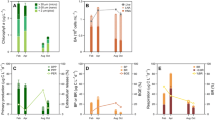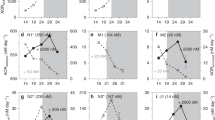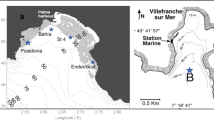Abstract
Arctic areas of deep-water convection have a large potential for export of organic carbon from surface waters into the deep sea and, therefore, are an important part of the global carbon cycle. As the Arctic is reportedly heating up faster than any other part of the planet, temperature-driven changes in the biogeochemical cycling in these areas can be very significant. Here, we study the regulation of bacterial carbon metabolism, which process vast amounts of organic carbon, by temperature and the availability of resources. The response of bacterial production and respiration of natural bacterial assemblages from the Fram Strait was studied by experimental manipulations of temperature and resources in combination. Both bacterial production and respiration were enhanced by temperature so that the total bacterial carbon demand increased sixfold following a temperature increase of 6°C. Respiration responded more strongly than production so that bacterial growth efficiency decreased with increasing temperature. Although neither production nor respiration was limited by resource availability under in situ conditions, the response to temperature was higher in resource-amended treatments, indicative of a substrate-temperature interaction regulating both components of bacterial metabolism. In conclusion, the results show that warming can result in a substantial increase of the carbon flow through bacteria and that most of the carbon consumed would be released as CO2. Moreover, the results suggest that both temperature and availability of resources need to be considered to accurately be able to predict changes in bacterial carbon metabolism in response to climate change.




Similar content being viewed by others
References
ACIA, Loeng H (2005) Marine systems. In: Symon C, Arris L, Heal B (eds) Arctic climate impact assessment. Cambridge University Press, New York, pp 453–538
Apple JK, del Giorgio PA, Kemp WM (2006) Temperature regulation of bacterial production, respiration, and growth efficiency in a temperate salt-marsh estuary. Aquat Microb Ecol 43:243–254
Arrigo KR, van Dijken G, Pabi S (2008) Impact of a shrinking Arctic ice cover on marine primary production. Geophys Res Lett 35:L19603. doi:10.1029/2008GL035028
Bjornsen PK (1986) Bacterioplankton growth-yield in continuous seawater cultures. Mar Ecol-Prog Ser 30:191–196
Crump BC, Hobbie JE (2005) Synchrony and seasonality in bacterioplankton communities of two temperate rivers. Limnol Oceanogr 50:1718–1729
Daneri G, Riemann B, Williams PJL (1994) In situ bacterial production and growth-yield measured by thymidine, leucine and fractionated dark oxygen-uptake. J Plankton Res 16:105–113
del Giorgio PA, Cole JJ (1998) Bacterial growth efficiency in natural aquatic systems. Ann Rev Ecol Evol S 29:503–541
del Giorgio PA, Duarte CM (2002) Respiration in the open ocean. Nature 420:379–384
Ducklow HW, Purdie AD, Williams PJL, Davies JM (1986) Bacterioplankton a sink for carbon in a coastal marine plankton community. Science (Washington D C) 232:865–867
Felip M, Pace ML, Cole JJ (1996) Regulation of planktonic bacterial growth rates: the effects of temperature and resources. Microb Ecol 31:15–28
Griffiths RP, Caldwell BA, Morita RY (1984) Observations on microbial percent respiration values in Arctic and subarctic marine waters and sediments. Microb Ecol 10:151–164
Hall EK, Neuhauser C, Cotner JB (2008) Toward a mechanistic understanding of how natural bacterial communities respond to changes in temperature in aquatic ecosystems. ISME J 2:471–481
Hartley IP, Hopkins DW, Garnett MH, Sommerkorn M, Wookey PA (2008) Soil microbial respiration in Arctic soil does not acclimate to temperature. Ecol Lett 11:1092–1100
Hassol SJ (2004) Impacts of a warming Arctic: arctic climate impact and assessment. Cambridge University Press, Cambridge
Holfort J, Hansen E (2005) Timeseries of polar water properties in fram strait. Geophys Res Lett 32:L19601. doi:10.1029/2005GL022957
Holm-Hansen O, Riemann B (1978) Chlorophyll a determination–improvements in methodology. Oikos 30:438–447
Hop H, Falk-Petersen S, Svendsen H, Kwasniewski S, Pavlov V, Pavlova O, Soreide JE (2006) Physical and biological characteristics of the pelagic system across Fram Strait to Kongsfjorden. Prog Oceanogr 71:182–231
IPCC, Christensen JH, Hewitson B, Busuioc A, Chen A, Gao X, Held I, Jones R, Kolli RK, Kwon W-T, Laprise R, Magaña Rueda V, Mearns L, Menéndez CG, Räisänen J, Rinke A, Sarr A, Whetton P (2007) Regional climate projections. In: Solomon S, Qin D, Manning M, Chen Z, Marquis M, Averyt KB, Tignor M, Miller HL (eds) Climate change 2007: the physical science basis. Contribution of working group i to the fourth assessment report of the intergovernmental panel on climate change. Cambridge University Press, Cambridge, pp 847–940
Kirchman DL (2001) Measuring bacterial biomass production and growth rates from leucine incorporation in natural aquatic environments. In: Paul JH (ed) Methods in microbiology, vol 30. Academic Press, London, pp 227–237
Kirchman DL, Hill V, Cottrell MT, Gradinger R, Malmstrom RR, Parker A (2009) Standing stocks, production and respiration of phytoplankton and heterotrophic bacteria in the western Arctic Ocean. Deep-Sea Res II 56:1237–1248
Kritzberg ES, Arrieta JM, Duarte CM (2010) Temperature and phosphorus regulating carbon flux through bacteria in a coastal marine system. Aquat Microb Ecol 58:141–151
López-Urrutia A, Morán XAG (2007) Resource limitation of bacterial production distorts the temperature dependence of oceanic carbon cycling. Ecology (Washington D C) 88:817–822
Meon B, Amon RMW (2004) Heterotrophic bacterial activity and fluxes of dissolved free amino acids and glucose in the Arctic rivers Ob, Yenisei and the adjacent Kara Sea. Aquat Microb Ecol 37:121–135
Middelboe M, Lundsgaard C (2003) Microbial activity in the Greenland Sea: role of DOC lability, mineral nutrients and temperature. Aquat Microb Ecol 32:151–163
Morita RY, Buck GE (1974) Temperature effects on marine microorganisms. In: Colwell RR, Morita RY (eds) Effect of the ocean environment on microbial activities. University Park, Baltimore, pp 124–129
Outdot CR, Gerard R, Morin P, Gningue I (1988) Precise shipboard determination of dissolved oxygen (Winkler procedure) for productivity studies with a commercial system. Limnol Oceanogr 33:146–150
Pomeroy LR, Wiebe WJ (2001) Temperature and substrates as interactive limiting factors for marine heterotrophic bacteria. Aquat Microb Ecol 23:187–204
Pomeroy LR, Wiebe WJ, Deibel D, Thompson RJ, Rowe GT, Pakulski JD (1991) Bacterial responses to temperature and substrate concentration during the Newfoundland spring bloom. Mar Ecol Prog Ser 75:143–159
Pommier T, Pinhassi J, Hagstrom A (2005) Biogeographic analysis of ribosomal RNA clusters from marine bacterioplankton. Aquat Microb Ecol 41:79–89
Porter KG, Feig YS (1980) The use of DAPI for identifying and counting the aquatic microflora. Limnol Oceanogr 25:943–948
Rivkin RB, Legendre L (2001) Biogenic carbon cycling in the upper ocean: effects of microbial respiration. Science (Washington, DC) 291:2398–2400
Roland F, Cole JJ (1999) Regulation of bacterial growth efficiency in a large turbid estuary. Aquat Microb Ecol 20:31–38
Sand-Jensen K, Pedersen NL, Sondergaard M (2007) Bacterial metabolism in small temperate streams under contemporary and future climates. Freshw Biol 52:2340–2353
Schauer U, Fahrbach E, Osterhus S, Rohardt G (2004) Arctic warming through the Fram Strait: oceanic heat transport from 3 years of measurements. J Geophys Res 109:C06026. doi:10.1029/2003JC001823
Sherr EB, Sherr BF (1996) Temporal offset in oceanic production and respiration processes implied by seasonal changes in atmospheric oxygen: the role of heterotrophic microbes. Aquat Microb Ecol 11:91–100
Siegenthaler U, Sarmiento JL (1993) Atmospheric carbon dioxide and the ocean. Nature (London) 365:119–125
Smith DC, Azam F (1992) A simple, economical method for measuring bacterial protein synthesis rates in seawater using tritiated-leucine. Mar Microb Food Webs 6:107–114
Sorteberg A, Furevik T, Drange H, Kvamsto NG (2005) Effects of simulated natural variability on Arctic temperature projections. Geophys Res Lett 32:L18708. doi:10.1029/2005GL023404
Tison DL, Pope DH (1980) Effect of temperature on mineralization by heterotrophic bacteria. Appl Environ Microb 39:584–587
Toolan T (2001) Coulometric carbon-based respiration rates and estimates of bacterioplankton growth efficiencies in Massachusetts Bay. Limnol Oceanogr 46:1298–1308
Vaqué D, Guadayol O, Peters F, Felipe J, Malits A, Pedros-Alió C (2009) Differential response of grazing and bacterial heterotrophic production to experimental warming in Antarctic waters. Aquat Microb Ecol 54:101–112
Vázquez-Domínguez E, Vaqué D, Gasol AM (2007) Ocean warming enhances respiration and carbon demand of coastal microbial plankton. Global Change Biol 13:1327–1334
Wassmann P (2008) Impacts of global warming on Arctic marine ecosystems and processes. In: Duarte CM (ed) Impactos del calentaniento global sobre los ecosistemas polares. Fundación BBVA, Spain, pp 111–138
White PA, Kalff J, Rasmussen JB, Gasol JM (1991) The effect of temperature and algal biomass on bacterial production and specific growth rate in freshwater and marine habitats. Microb Ecol 21:99–118
Wiebe WJ, Sheldon WM Jr, Pomeroy LR (1992) Bacterial growth in the cold: evidence for an enhanced substrate requirement. Appl Environ Microbiol 58:359–364
Williams PJL (2000) Heterotrophic bacteria and the dynamics of dissolved organic material. In: Kirchman DL (ed) Microbial ecology of the oceans. Wiley-Liss, New York, pp 153–200
Williams PJL, del Giorgio PA (2005) Respiration in aquatic ecosystems: history and background. In: Williams PJL, del Giorgio PA (eds) Respiration in aquatic ecosystems. Oxford University Press, New York, pp 1–17
Wohlers J, Engel A, Zöllner E, Breithaupt P, Jürgens K, Hoppe H_G, Sommer U, Riebesell U (2009) Changes in biogenic carbon flow in response to sea surface warming. PNAS 106:7067–7072
Yannarell AC, Kent AD, Lauster GH, Kratz TK, Triplett EW (2003) Temporal patterns in bacterial communities in three temperate lakes of different trophic status. Microb Ecol 46:391–405
Acknowledgments
This research is a contribution to the Arctic Tipping Points project (www.eu-atp.org) funded by FP7 of the European Union (contract #226248), iAOOS, a Complementary Action from the Spanish Ministry of Science and Education (reference CGL2007-28773-E/ANT) and the ARCTOS network. Financial support was provided by the Norwegian Research Council through its International Polar Year programme and the project iAOOS Norway—Closing the Loop (grant # 176096/S30; http://www.iaoos.no). We thank the crew and captain of the University of Tromsø research vessel Jan Mayen for support, and Raquel Vaquer Sunyer, Tobias Tamelander, Sigrid Øygarden, Alexey Pavlov and Marit Reigstad for assistance. We are indebted to the Arctic sea fog that came just in time to study a 97% eclipse of the sun with our bare eyes.
Author information
Authors and Affiliations
Corresponding author
Rights and permissions
About this article
Cite this article
Kritzberg, E.S., Duarte, C.M. & Wassmann, P. Changes in Arctic marine bacterial carbon metabolism in response to increasing temperature. Polar Biol 33, 1673–1682 (2010). https://doi.org/10.1007/s00300-010-0799-7
Received:
Revised:
Accepted:
Published:
Issue Date:
DOI: https://doi.org/10.1007/s00300-010-0799-7




